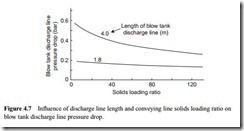Problems with moisture
With materials that are hygroscopic, air drying is normally recommended. For the majority of materials this is not generally necessary. With compressors, however, large quantities of moisture can be generated if the supply air is warm and humid, and this moisture can be carried over into the air supply lines. With materials such as fly ash and cement this moisture can cause blinding of the blow tank fluidizing membrane, which can result in a significant increase in pressure drop across the blow tank and hence a reduction in performance of the conveying system.
Owing to the intermittent nature of the conveying process it is also possible for water to collect in the air supply lines and this can be blown into the blow tank on start up. This has resulted in partial blockage of the blow tank discharge line on several occasions with both fly ash and cement in pneumatic conveying systems operated by the author. This particular topic of moisture and condensation is considered in detail in Chapter 25.
Road and rail vehicles
Many road and rail vehicles used for the transport of bulk solids are essentially blow tanks. In the case of road tankers the vehicle usually has its own air supply for off- loading. These are generally rated at a pressure of 1 bar gauge and positive displace- ment blowers are used for the purpose. Rail vehicles generally rely on a site air supply for off-loading, with a much higher air pressure. A standard carriage length rail wagon transporting cement would typically carry about 70 tonne.
